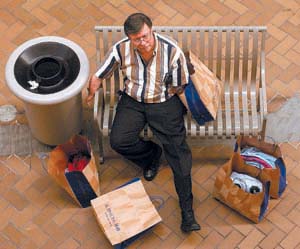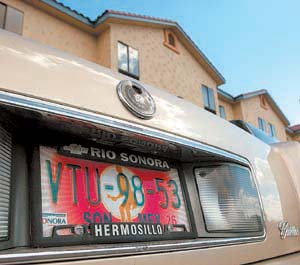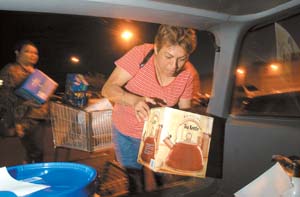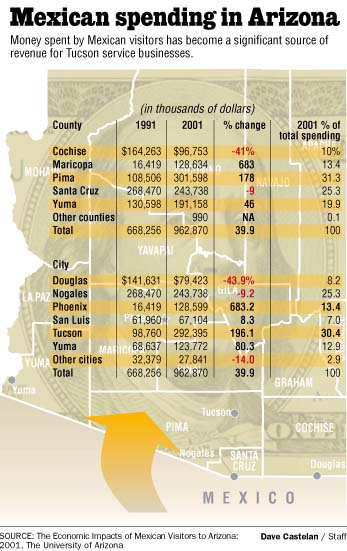

Sunday, 6 October 2002
http://www.azstarnet.com/star/today/21006tradesecrets-DAY12fpmb2f.html
From hotels to hospitals, Tucson firms angle for business from wealthy Mexican
consumers - one part of a growing local strategy to parlay the border nearby
into a lift for the local economy. This special three-day series explores how
business leaders and others hope to expand Tucson's status as the big store
into a whole lot more.
 |
TAKING A BREAK: Robert Zaragoza of Ciudad Obregón, Sonora, rests as his
wife, Myrna, shops at the Disney Store in Tucson Mall, where 70 percent of Mexican
visitors go.
 |
David Sanders / Staff
COME ON INN: Hampton Inn and Suites entices travelers from Sonora with special family packages.
 |
David Sanders / Staff
COSTCO CONSUMERS: Julieta Alvarado, right, and friend Patty Rivera of Nogales,
Sonora, pack up their Costco purchases.
Story by Paola Banchero • Photos by David Sanders
ARIZONA DAILY STAR
|
SPENDING 2001 |
 |
Few cities of Tucson's size lie so close to a nation where corporate America
has found not only a skilled and hard-working labor force but also a middle-class
market of 35 million people with a growing appetite for U.S. products and services.
The desire for more American clothes, food and electronics - whose prices in Mexico have jumped as the value of the peso has dropped 11 percent this year - helps explain the number of cars from Sonora and Sinaloa parked at Tucson shopping malls. It has local businesses, from hotels to hospitals, courting Mexican visitors like never before.
Visitors from Mexico spent an estimated $827,000 every day in Pima County last year - the equivalent of 26,000 Gap button-down shirts or 5,500 middle-of-the-line DVD players - while providing jobs to 7,000 people, indirectly to 2,600 more. And that was during a recession.
But making the most of Mexico goes beyond shopping trips and hotel stays.
In a city that began as part of colonial Spain and was later an outpost of the Republic of Mexico, historic and cultural ties are strong. Linking Tucson's economy with Mexico's is a bigger challenge, but one with a huge potential payoff, local business and government leaders say.
Trade with Mexico could help boost wages that trail the state's and the nation's: Pima County's median household income was $36,758 in 1999, compared with $45,358 in Maricopa County and $41,994 for the nation.
Local trade proponents are working to:
* Make Tucson a prime U.S. destination for Mexicans to shop, bank, invest, vacation and seek medical care.
* Transform the city into a desert port, creating business opportunities and new jobs for people who ship and store goods on their way to this growing consumer market.
* Help Tucson become a base for companies that do business in Mexico, where they open small manufacturing plants to capitalize on cheaper labor and high-tech expertise south of the border.
"Passage of the North American Free Trade Agreement started a light rain that has soaked the topsoil," said Augie García, director of the Tucson-Mexico Trade Office. "Large companies have taken advantage in the lowering of barriers to trade since NAFTA, but that's not necessarily true of local companies. What we need now is a downpour, so international commerce can take root in the region."
Courting Mexican visitors
Tucson companies do not manufacture toothpaste, clothing or radios to peddle in Mexico. So they sell their home town, luring well-heeled Mexicans to local malls, hotels, restaurants and museums.
Beefing up Tucson's already healthy tourism trade might not broaden the local economy, but it would pump more money into local coffers. Mexican visitors spent $302 million in Pima County in 2001 - more than in any other Arizona county, according to a recent University of Arizona study. That's almost one-third of the $963 million statewide total.
"A tremendous amount of revenue that we derive in Tucson we derive because of our trade with Mexico," Tucson Mayor Bob Walkup said. "It is people coming here and shopping here. It's tourism and trade, too."
Walkup has visited Mexico six times since taking office three years ago. And Mexico is coming up frequently on the campaign trail for statewide office.
"It's not just the manufacture of products, but the transport of products from all across the world through Mexico and into Arizona. I see that as strengthening both of our economies," Republican gubernatorial candidate Matt Salmon said.
His opponent, Democrat Janet Napolitano, is equally interested in strengthening cross-border ties: "If we are going to be involved in international commerce at any level, we have to build those relationships with Mexico," she said.
If Tucson wants to benefit from those relationships, it must offer more to Mexican visitors, who can spend time and money in other Southwestern cities, including Phoenix. The threat is great: Those who choose Phoenix tend to stay there longer and spend more money than they do in Tucson.
A tepid recovery is under way in Mexico, with retail sales expected to grow 1.9 percent for the year, but the falling peso has forced shopkeepers there to raise prices since spring - sometimes two or three times a month. That makes shopping north of the border, if not always economical, at least predictable.
Mexican visitors have helped retailers along the Arizona border weather a two-year economic slowdown at home, as they did in the 1990s - a decade when the peso crashed but Tucson saw spending by Mexican visitors increase nearly 200 percent.
[PICTURE]
David Sanders / Staff
PLAZA DEL SOL: Guadalajara shoppers head for Latin America's oldest mall in
droves.
"We have two missions: keep Mexicans interested in spending money in Tucson
by expanding our retail offerings, and market farther into Mexico," said
García, of the Tucson-Mexico Trade Office. The office, along with the
Metropolitan Tucson Convention and Visitors Bureau, has marketed Tucson to Sonora
and Sinaloa for four years.
"Our proximity to Mexican consumers has proven to be a boost to our economy. We need to make sure this continues to be so."
"The personal touch"
Businesses that already try to reach customers across the border say Mexican visitors help balance the slow summer season and provide an extra boost during the high season.
The Hampton Inn and Suites at 5950 N. Oracle Road fills up in June, July and August by offering $59 rooms and $69 suites and enticing Mexican travelers with packages for families or extended families traveling in groups, said Jerry Gutierrez, who handles international business at the hotel.
"Everyone looks for the thing that can supplement their business, and Mexican visitors supplement ours," Gutierrez said. "We give them the personal touch, greet them at the door, give them an abrazo (a hug). Sometimes I feel like I'm running for office, with as many kids as I kiss."
It's working. On a recent Sunday morning, one of every three vehicles at the hotel had Sonora plates. Inside, Mexican families noshed on bagels before heading to the Oracle retail strip.
Almost 70 percent of the Mexican shoppers who come to Tucson shop at Tucson Mall, and Gutierrez has keyed in on them by touting his proximity to the mall in Sonoran publications. That's how Jorge and Lilian Solano learned of the Hampton Inn and Suites.
They come to Tucson every four months to shop, especially for 9-month-old daughter Liliana María.
[PICTURE]
Jorge, a veterinarian who earns about $2,000 a month managing a pig farm, said the trips help him stretch the family budget, even considering the gas and taxes they pay on bigger items once they drive back into Mexico.
"We've found that the things we shop for are cheaper and of better quality here," said Lilian. Last weekend, the Solanos were finishing up a five-day trip from their hometown of Ciudad Obregón, seven hours south of Tucson. They had bought clothes for Liliana and her cousins, plus a Canon camera that retailed for almost $100 less than another Canon with fewer bells and whistles that they had seen back home.
Most of the Mexican guests at the Hampton Inn have plenty of money to shop. Many of them invite Gutierrez, the manager, to stay at their beachfront homes or sprawling ranches - signs they are among the estimated 15 million Mexicans whom economists define as upper class.
To attract more of them, Premier Hotel Group, which manages the Hampton Inn, will open the higher-end La Posada Lodge and Casitas next door in December. It's the site of the old Cliff Manor Inn, another pioneering tourist site that lured tourists from back East. Deluxe rooms are expected to cost $239 a night.
The market should be able to bear that price. More than 16 percent of visitors from Sonora earn at least $2,000 a month; 84 percent of travelers from Sinaloa fall into that category.
Beyond shopping
That potential is making other businesses take notice.
"This is a market we're extremely interested in," said Kimberly Sundt, regional director of public relations at Loews Ventana Canyon Resort. "Mexicans who come up from the Hermosillo area come for the same reason we have Phoenicians coming down. It's not too far away and it's an escape."
Sundt wrote a marketing plan aimed at Mexican visitors last month and will begin outreach efforts for the holidays.
The developer of La Encantada, an upscale shopping center going up at East Skyline Drive and North Campbell Avenue, also plans to try to reach Mexican consumers with marketing materials when the center opens next October.
"The market will be a factor in the success of the center," said Mitch Stallard, vice president of development for Westcor Partners. "We will develop an entire program at La Encantada oriented toward the Mexican visitor."
Comfort and luxury are the focus when La Encantada opens next fall. It promises to bring new retailers to the Tucson market, such as home store Pottery Barn, which should draw more wealthy Mexican visitors to town.
While malls, restaurants and hotels are the obvious beneficiaries of Mexican spending, other local companies are angling for their own chunk of the business.
David Fenner started Sun West Aviation, an air charter business, in 1996 to shuttle Americans and Mexicans back and forth for business and recreation.
Earlier this year, he partnered with Jorge Zaied, a Mexican national with homes in Tucson and Nogales, Sonora, and business interests on both sides of the border.
Sun West, with the exception of a three-month downturn after the Sept. 11 terrorist attacks, has grown 25 percent every year since 1996.
"If we're not carrying tourists from the United States to Mexican recreational areas," Fenner said, "we're carrying Mexican nationals who have a second home in Tucson or who are traveling on business."
Zaied, for example, has traveled with family, friends and business partners to San Diego for golf, Puerto Vallarta to stroll the beach, and Monterrey, Mexico, to leave a son at college.
Tucson Heart Hospital also has a new program aimed at Mexican consumers, said Jim Snodgrass, the hospital's business development coordinator.
The hospital is pairing diagnostic tests with a weekend tourist package. Prospective patients will get coronary exams, weekend hotel rates and certificates to restaurants.
"We're working with physicians in Mexico to build better relationships with Mexican visitors to Tucson," Snodgrass said. "When Mexican visitors come to Tucson to shop, they can meet physicians here. So when they come back, they will be familiar with our hospital and the quality of service we offer."
The overall economic impact of Mexican visitors - wealthy tourists as well as illegal border-crossers struck down by desert heat - remains deeply in the red when it comes to health care, though. Pima County ranks No. 3 among 24 U.S. border counties in medical expenses left unpaid by Mexican nationals - an estimated $25 million a year.
"It concerns me when a certain segment of the community talks about how the health care industry should market to Mexico, about how positive are the expenditures from foreign visitors," said Barbara Felix, head of international patient services at University Medical Center. "The vast majority of Mexicans we see can't pay."
Expanding the middle class
Mexico's citizens now number 100 million - almost 20 times Arizona's population. Pinched between a vast poor population and a tiny elite, the middle class is inching back to solid ground after losing nearly 40 percent of its purchasing power when the peso's value sank in late 1994 and early 1995.
"This is a country of such contrasts," said Leticia Bautista, a Mexico City coffeehouse worker. "You see children begging in the streets, but you also see people who feel, maybe for the first time in our history, like they can afford some of the things they want."
Bautista, 23, earns $264 a month, placing her in the ranks of the lower middle class.
Typical of many urbanites, she can't afford the rents that make Mexico City the world's 28th-most expensive city - on par with Houston, according to a recent cost of living survey. So Bautista lives with her mother and commutes to the trendy neighborhood where she works.
Whether lasting improvement comes from the increasing trade with the United States and the rest of the world is in dispute. Bautista says her paycheck stretches just far enough to buy food, clothes and medicine for her and her toddler daughter. She nevertheless sides with the 68 percent of Mexicans who credit open markets with creating jobs and prosperity.
Mexicans were less interested in products imported from the United States before NAFTA went into effect, dropping tariffs and other restrictions on trade among Canada, the United States and Mexico. U.S. brands now are everywhere, from the smallest abarrote, or corner shop, to the biggest retailers.
"Now the younger generation can't get enough of it. They are the NAFTA generation. They embrace the United States and its culture, much more than their parents or grandparents have," said Tim Travis, a Prescott man who is wending his way through Mexico on a bike and compared his findings to a trip a few years ago.
The numbers jibe with his observations. Mexico's trade with the United States jetted to $233 billion in 2001 from $81 billion in 1993.
After 20 years of economic reform that opened the Mexican market to U.S. consumer goods, Mexicans have caught the bug for spending leisure time and money in the United States. And they love to shop. In such prosperous cities as Guadalajara, the fertile Silicon Valley of Mexico, families go in droves to the malls. Guadalajara's Plaza del Sol - Latin America's oldest mall - still uses parking attendants to direct shoppers to parking spaces in the crowded lot.
The phenomenon of Mexican consumer power stretches to U.S. cities across the Southwest as Mexicans hunt for bargains next door. Many products are cheaper in the United States because of greater competition and a more advanced system of getting goods to market.
The trend has economists and merchants expecting more.
"I think the trade flows are going to increase, expanding the middle class in the process," said Bruce Wright, associate vice president for economic development at the University of Arizona's Office of Economic Development.
"By some estimates, the middle class is as big as the entire state of California - definitely big enough we shouldn't ignore it."
* Contact reporter Paola Banchero at 573-4237 or banchero@azstarnet.com.
Back to Story
--------------------------------------------------------------------------------
All content copyright © 1999, 2000, 2001 AzStarNet, Arizona Daily Star
and its wire services and suppliers and may not be republished without permission.
All rights reserved. Any copying, redistribution, or retransmission of any of
the contents of this service without the expressed written consent of Arizona
Daily Star or AzStarNet is prohibited.